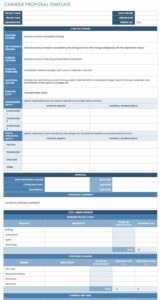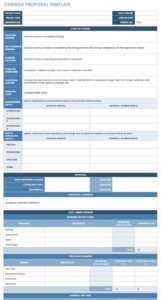Utilizing a pre-defined structure for documenting modifications promotes clear communication, minimizes misunderstandings, and facilitates efficient processing of requests. This streamlined approach reduces the likelihood of errors and delays, ensuring that changes are implemented accurately and effectively. Consistent documentation also contributes to better project management and creates an auditable history of modifications, valuable for future reference and analysis.
Further exploration will delve into the key components of these structured forms, examples of their practical application, and best practices for their effective utilization within software development processes.
Key Components of a Standardized Change Form
Effective management of software modifications necessitates a structured approach to documenting and communicating change requests. Several key components ensure clarity and completeness in these requests.
1. Request Identifier: A unique identifier, such as a sequential number, allows for easy tracking and referencing of the request throughout its lifecycle.
2. Requestor Information: Details about the individual or team requesting the change, including their name, department, and contact information, are essential for communication and clarification.
3. Date of Request: Timestamping the request provides context and helps in managing timelines and prioritizing tasks.
4. Description of Change: A clear and concise description of the desired modification, explaining the nature and scope of the change, is crucial for understanding the request.
5. Justification/Rationale: Explaining the reason behind the change, including the problem being addressed or the improvement being sought, helps to assess its value and priority.
6. Impact Assessment: An evaluation of the potential impact of the change on existing functionalities, performance, and other systems is essential for mitigating risks and ensuring compatibility.
7. Priority Level: Assigning a priority level (e.g., critical, high, medium, low) helps to prioritize implementation efforts and allocate resources effectively.
8. Proposed Solution: A suggested approach or solution for implementing the change, including technical details and design considerations, facilitates the development process.
These elements provide a comprehensive framework for documenting change requests, enabling efficient evaluation, prioritization, and implementation of software modifications.
How to Create a Software Change Request Form
Creating a well-structured form for requesting software changes is crucial for managing the development process effectively. A standardized template ensures clarity, consistency, and traceability of requested modifications.
1. Define Required Fields: Begin by identifying the essential information needed to document a change request comprehensively. These fields typically include a unique identifier, requestor details, date, description of the change, justification, impact assessment, priority level, and proposed solution.
2. Choose a Format: Select an appropriate format for the template, such as a word processing document, spreadsheet, or dedicated software tool. Consider accessibility and ease of use for all stakeholders.
3. Structure the Layout: Organize the fields logically within the template to facilitate easy completion and review. Group related information together and use clear headings and labels.
4. Provide Clear Instructions: Include concise instructions for completing each field to ensure consistency and accuracy in the information provided.
5. Establish a Review Process: Define a clear process for reviewing and approving change requests, including designated roles and responsibilities for stakeholders.
6. Implement Version Control: Track versions of the template to maintain a record of changes and ensure that the most current version is used.
7. Train Users: Provide training to all stakeholders on how to use the template effectively and adhere to the established change management process.
A well-designed form supports effective communication and collaboration between stakeholders and development teams. It streamlines the process of requesting, evaluating, and implementing software modifications, ultimately contributing to improved project outcomes.
Standardized forms for requesting software modifications provide a structured framework for managing the evolution of software systems. These forms facilitate clear communication, efficient processing, and comprehensive documentation of requested changes, minimizing the risk of errors and delays. Key components such as unique identifiers, detailed descriptions, justifications, impact assessments, and proposed solutions ensure that requests are thoroughly evaluated and implemented effectively.
Effective change management is essential for the long-term success of any software project. Implementing robust processes, supported by well-designed templates, enables organizations to adapt to evolving needs, enhance software quality, and maximize return on investment. Continuous improvement of these processes, informed by best practices and industry standards, is crucial for maintaining agility and competitiveness in the dynamic landscape of software development.


